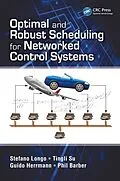Optimal and Robust Scheduling for Networked Control Systems tackles the problem of integrating system components-controllers, sensors, and actuators-in a networked control system. It is common practice in industry to solve such problems heuristically, because the few theoretical results available are not comprehensive and cannot be readily applied by practitioners. This book offers a solution to the deterministic scheduling problem that is based on rigorous control theoretical tools but also addresses practical implementation issues. Helping to bridge the gap between control theory and computer science, it suggests that the consideration of communication constraints at the design stage will significantly improve the performance of the control system.
Technical Results, Design Techniques, and Practical Applications
The book brings together well-known measures for robust performance as well as fast stochastic algorithms to assist designers in selecting the best network configuration and guaranteeing the speed of offline optimization. The authors propose a unifying framework for modelling NCSs with time-triggered communication and present technical results. They also introduce design techniques, including for the codesign of a controller and communication sequence and for the robust design of a communication sequence for a given controller. Case studies explore the use of the FlexRay TDMA and time-triggered control area network (CAN) protocols in an automotive control system.
Practical Solutions to Your Time-Triggered Communication Problems
This unique book develops ready-to-use engineering tools for large-scale control system integration with a focus on robustness and performance. It emphasizes techniques that are directly applicable to time-triggered communication problems in the automotive industry and in avionics, robotics, and automated manufacturing.
Autorentext
Dr. Stefano Longo is currently a lecturer in vehicles electrical and electronic systems in the Department of Automotive Engineering at Cranfield University, UK. His work and his research interests gravitate around the problem of implementing advanced control algorithms in hardware, where the controller design and the hardware implementation are not seen as two separate and decoupled problems, but as a single interconnected one.
Dr. Tingli Su is a researcher at the Beijing Institute of Technology. In 2009 she was invited by the University of Bristol as an exchange Ph.D. student, sponsored by the Chinese Scholarship Council during the first year and Jaguar & Land Rover Research the following year. Within the exchange period, she explored the field of nonlinear network control systems (NCS) with communication constraints.
Dr. Guido Herrmann is a reader in control and dynamics in the Department of Mechanical Engineering at the University of Bristol. His research considers the development and application of novel, robust, and nonlinear control systems. He has been collaborating with several institutions in Australia, China, Malaysia, Singapore, and the USA and has been working with companies such as Western Digital and Jaguar Land Rover.
Dr. Phil Barber, BSc Ph.D. CEng MIET FIMechE, is currently the technical specialist for chassis systems and vehicle capability research at Jaguar Land Rover. Current interests include vehicle dynamics, state estimation, distributed and networked systems for real-time vehicle control, and regenerative braking. A member of the Institution of Engineering and Technology, he serves on the executive team of their Automotive and Road Transport Systems Network.
Klappentext
Optimal and Robust Scheduling for Networked Control Systems tackles the problem of integrating system components-controllers, sensors, and actuators-in a networked control system. It is common practice in industry to solve such problems heuristically, because the few theoretical results available are not comprehensive and cannot be readily applied by practitioners. This book offers a solution to the deterministic scheduling problem that is based on rigorous control theoretical tools but also addresses practical implementation issues. Helping to bridge the gap between control theory and computer science, it suggests that the consideration of communication constraints at the design stage will significantly improve the performance of the control system. Technical Results, Design Techniques, and Practical ApplicationsThe book brings together well-known measures for robust performance as well as fast stochastic algorithms to assist designers in selecting the best network configuration and guaranteeing the speed of offline optimization. The authors propose a unifying framework for modelling NCSs with time-triggered communication and present technical results. They also introduce design techniques, including for the codesign of a controller and communication sequence and for the robust design of a communication sequence for a given controller. Case studies explore the use of the FlexRay TDMA and time-triggered control area network (CAN) protocols in an automotive control system.Practical Solutions to Your Time-Triggered Communication ProblemsThis unique book develops ready-to-use engineering tools for large-scale control system integration with a focus on robustness and performance. It emphasizes techniques that are directly applicable to time-triggered communication problems in the automotive industry and in avionics, robotics, and automated manufacturing.
Inhalt
Introduction
Overview
Motivation
Control of Plants with Limited Communication
Introduction
Practical considerations
Models for NCSs
Control methods
Scheduling methods
Scheduling and controller codesign methods
Structural and stability analysis
Nonlinear NCSs
Summary
A General Framework for NCS Modeling
Introduction
Limited communication and schedulers
NCS modeling
NCS without ZOH
Periodicity and discrete-time lifting
Extension to multi-networks, subnetworks and task scheduling
Multirate systems, a special case of NCSs
NCSs, a special case of switched and delayed systems
Application to a vehicle brake-by-wire control system
Summary
Controllability and Observability
Introduction
NCSs with ZOH
NCSs without ZOH
Sampled-data case
Examples
Summary
Communication Sequence Optimization
Introduction
Optimization problem
Optimization algorithms
Constraint handling
Optimizing for
Optimization of NCSs which are multirate systems
Applying the optimization to the vehicle brake-by-wire control system
Summary
Optimal Controller and Schedule Codesign
Introduction
Problem formulation
Optimal codesign
Examples
Summary
Optimal Schedule Design
Introduction
Problem formulation
Optimal design
Examples
Summary
Robust Schedule Design
Introduction
Formulation of an H8-based cost for performance
Formulation of a discrete H8-based cost for robustness and performance
Formulation of a sampled-data H8-based cost for robustness and performance
Optimal design with an example
Summary
Application to an Automotive Control System
Introduction
Vehicle model and controller design
HIL from TTE systems
Experiments on the HIL
Experiments with FlexRay
Summary
Schedule Design for Nonlinear NCSs
Introduction
Discretization of nonlinear affine systems
Sampled-data model of nonlinear NCS
Quadratic cost functi…
